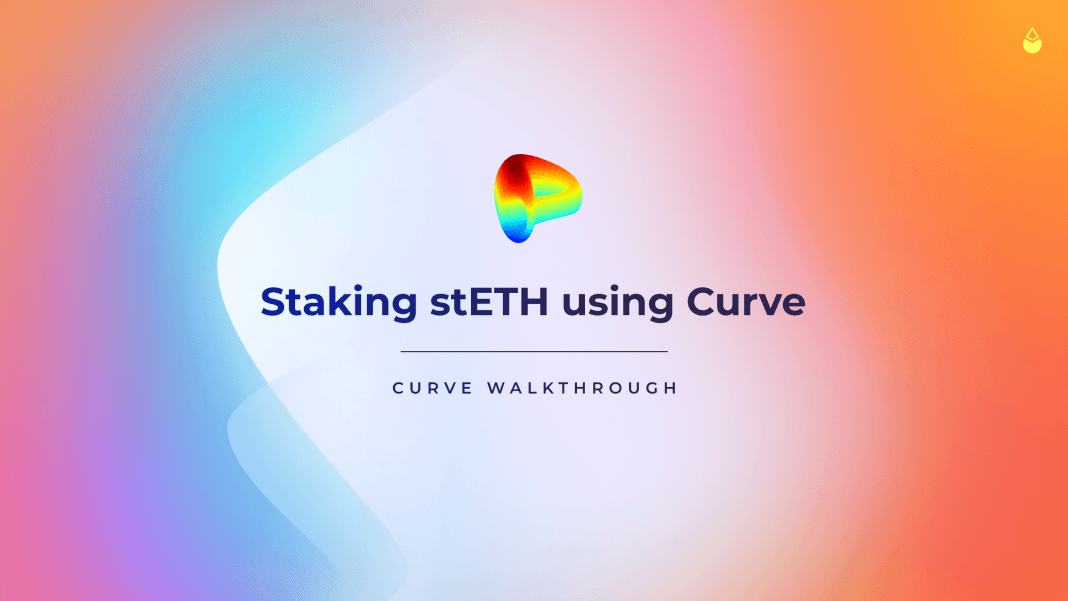Summary
- Provide liquidity in the Curve stETH pool and receive pool trading fees in CRV.
- Receive LDO rewards proportional to your provided liquidity.
- Retain your exposure to stETH to earn staking rewards.
- Unstake whenever you decide to.
- Participate in the Lido DAO with newly acquired LDO.
How does it work?
The stETH pool is a liquidity pool that contains stETH and ETH. Users can interact with these pools to purchase stETH or ETH with low slippage. Any transactions that take place within this pool are paid out to liquidity providers via trading fees in CRV.
Users who provide their liquidity to this pool will receive LP tokens in return. They can then stake their LP tokens into the Curve gauge to receive trading fees in CRV, alongside the newly proposed incentivized rewards; LDO and CRV.
Why is this important?
Without a liquidity pool for stETH, users cannot swap their stETH for ETH. This swapping between stETH and ETH effectively unstakes their ETH from the Lido contract. Without any liquidity pools, users will not be able to unstake their staked ETH until Ethereum launches Phase 2.
To incentivize liquidity for stETH, liquidity providers will be rewarded for providing their tokens into the Curve liquidity pool. In this way, liquidity providers will be incentivized to keep Lido liquid, where users can decide to unstake their ETH at any time for whatever amount. This proposal will benefit the Lido ecosystem and reward the early adopters who have interacted directly with Lido.
Curve Walkthrough
How do I provide liquidity into Curve?
- Visit www.curve.fi/steth/deposit and connect your wallet.
- Provide liquidity in the Curve stETH pool by clicking “Deposit & stake in gauge”.
- Choose the proportion of ETH/stETH to stake.
- Modify the gas price and confirm the transaction.
- Receive LP tokens in return.
- These LP tokens should be automatically deposited into the gauge.
- Start receiving LDO and CRV rewards in real time alongside trading fees in CRV (base APY %).
When you deposit stETH to Curve, your tokens are split between ETH and stETH, with the precise balances fluctuating constantly due to price trading.
This is done automatically and does not affect your share of the LDO distribution.
How do I use Curve gauges?
When using Curve, users can stake their LP tokens into the Curve gauge liquidity system to earn additional trading fees (CRV) and incentivized rewards (CRV & LDO).
To stake your stETH tokens in gauge:
- Visit www.curve.fi/steth/deposit.
- If you have not made your first deposit, press “Deposit and stake in gauge”. This will automatically stake your deposited stETH and you will start earning steCRV.
- If your stETH is already deposited but not staked, press “Stake unstaked in gauge”.
- Using the ‘stake %’ field, choose the amount you want to stake. This can be unstaked anytime.
Please note that when you stake your LP tokens – steCRV – using gauge, they will no longer be visible in your Metamask wallet. They will be visible again upon unstaking.
How do I claim my rewards?
Every time someone trades on this Curve pool you will receive trading fees in CRV. They are accrued automatically every trading transaction and you do not need to do anything here.
To claim your rewards:
- Visit the Withdraw page.
- Click on “Claim” to receive your rewards – sent to your wallet – and to keep staking.
- To exit the pool entirely, click “Withdraw and claim”. Upon doing so you will receive your rewards and withdraw your tokens from Curve back to your wallet.
How do I withdraw stETH from Curve
Curve allows you to unstake and withdraw at any time, in the token of your choice. When unstaking from gauges you effectively unstake your stETH so you no longer earn steCRV tokens.
- Unstake: To no longer stake your stETH in a Curve gauge to earn fees and additional steCRV LP tokens.
- Withdraw: To withdraw your tokens from Curve to your wallet.
There are 3 options when withdrawing from Curve – withdraw, withdraw & claim, unstake from gauge. To withdraw your tokens from Curve you will first need to unstake if doing so. To unstake your stETH from Curve:
- Visit the Withdraw page.
- Access the ‘advanced unstaking options’ towards the bottom of the dashboard.
- Here you will see an overview of your staked tokens. Choose the amount of tokens you want to unstake and press ‘Unstake staked’.
After unstaking your tokens you can now withdraw them from Curve.
- To exit the pool entirely, click “Withdraw and claim”. Upon doing so you will receive your rewards and withdraw your tokens from Curve back to your wallet.
- Fill in the total amount of tokens you wish to withdraw (share of liquidity) or the precise token amounts (in ETH and stETH). You can also choose the combination of tokens to withdraw to your wallet – the split between ETH and stETH.
Upon confirmation of withdrawal using your Ethereum wallet, your tokens will be withdrawn from Curve to your wallet.
What’s to come?
Another liquidity pool for stETH has been proposed. The stETH/DAI liquidity pool has been proposed by 0xMaki, a core team member and developer of SushiSwap, to be used in SushiSwap’s Onsen program.
There are many plans for stETH to be used in a variety of DeFi protocols in the future such as lending protocols, yield farming strategy protocols, aggregators, and many more to come. These are outlined in more detail here: Possible DeFi protocol integrations with Lido and their respective incentives.
We highly encourage users to submit their proposals on the Lido forums to share their ideas to the community.


